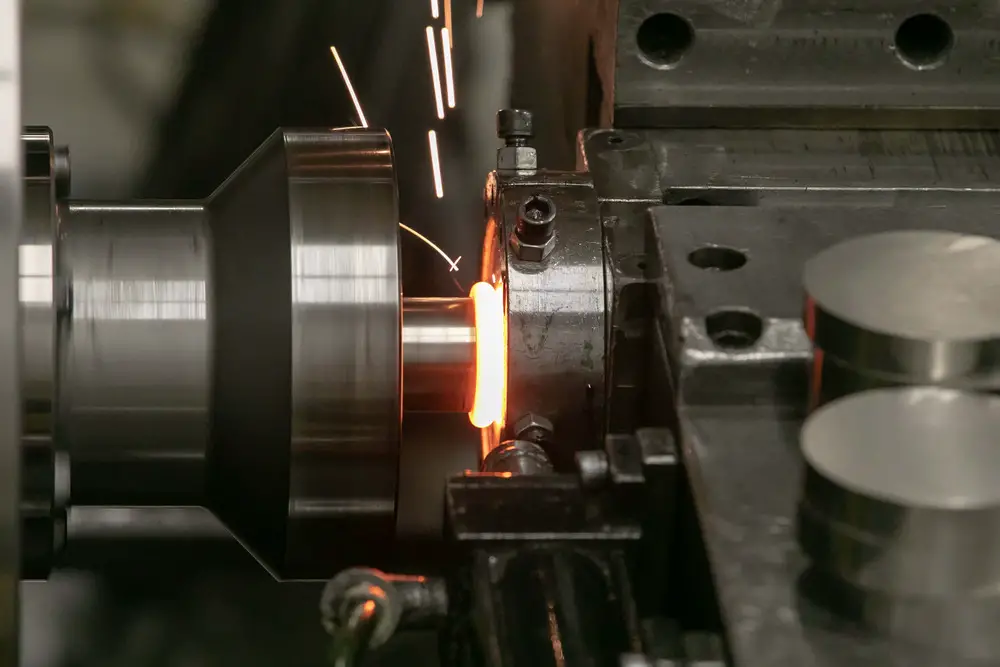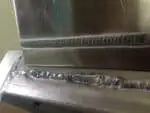Friction welding is a unique welding procedure. Welding happens in this form of welding as a result of external pressure applied to the solid state. Both the plates or work piece to be joined are either spinning or moving relative to one another during the friction welding process.
The fundamental benefit of friction welding is the ease with which the joining may be accomplished. It is an environmentally benign method that produces no smoke and has a restricted heat impacted zone, resulting in no change in the characteristics of heat sensitive materials. In most circumstances, no filler metal is required, and the welding strength is high.
Let us understand the pros and cons of friction welding better in this article.
But first,
What is Friction Welding?
Friction Welding is a solid-state welding technology that generates welds by the compressive force contact of rotating or moving work parts. Friction generates heat by displacing material plastically from the faying surfaces.
In this type of welding, the workpieces are bonded either relative to one other or by spinning to produce friction and displace the material on the surface. Extremely high pressure is required to create the friction and to finish the weld.
Different types of Friction Welding
Friction welding is classified into four types:
1.) Welding via Rotary / Spin Friction- A spinning chuck and a flywheel are used in spin welding. When the desired speed is reached, the motor disengages from the flywheel.
2.) Welding Using Linear Friction- An oscillating chuck is used in linear friction welding. When contrasted to spin welding, it is used on non-round objects. The welded material must have a high shear strength. An oscillating chuck is used in linear friction welding.
When contrasted to spin welding, it is used on non-round objects. The welded material must have a high shear strength.
3.) Welding by Friction Stir- Friction surfacing is a type of surface covering. Mechtrode is the coating substance, which is spun under pressure over the substrate.
4.) Spot Welding Using Friction Stir- A friction stir welding tool has a cylindrical shoulder and a contoured probe. A pin or nib is employed. Friction is formed between the worked metal, the nib, and the shoulder.
Advantages of Friction Welding
1.) Runs on standard power- The same voltages that power electric motors can power friction welding equipment, making it a good choice for industrial assembly.
2.) No filler needed- There is no need to utilise consumables such as filler rod or wire during friction welding. The surfaces of the two metal pieces are welded together face to face, with no additional material between them.
3.) No slag- Unlike other techniques of welding, friction welding produces no spatter or slag, which might harm the structural integrity of the joint or impair the overall look of the finished weld.
4.) Completely solid contact- Unlike handed welding, which can result in breaking at the weld seam’s borders or from uneven heat application, friction welding provides an equal application of heat throughout the whole welding surface. This produces a more mechanically flawless weld than would be possible by hand.
5.) No shielding gas required- Friction welds, unlike TIG and MIG welding techniques, do not require a shielding gas to prevent corrosion. This is an essential factor to consider since the inert gas mixes used in electrical welding may be expensive.
6.) There is no production of smoke or fumes- Unlike other forms of welding, which can generate toxic gases to breathe, friction welding produces no smoke or particles. This results in a more ecologically friendly and safer method of welding than combustible welding procedures.
7.) Durability- Friction welding produces not just strong welds, but also welds that remain strong. This is especially important in the high-performance settings that friction-welded components face during post-production procedures. One of the reasons friction welding is so popular in the maritime, aviation, and space sectors is its durability.
8.) Lower production costs- Because friction welding does not require filler or flux and can be automated, it is less expensive overall than other types of welding, even if the process itself is still costly to set up at the factory design level. Lower production costs lead to better profitability and lower consumer expenses.
9.) Airtight welds- Friction welds are airtight, making them ideal for both air and water vehicles, particularly those working in high-pressure situations. Stable friction welds assist keep this craft’s operators safe from decompression mishaps.
10.) Accurate results- Because friction welding is an automated process rather than being done by hand, the resultant welds are more consistent and less prone to introduced faults such as porosity or brittleness.
Disadvantages of Friction Welding
1.) It is not ideal for combining heavy metals or fragile materials like aluminum and stainless steel.
2.) The main downside of friction welding is that it causes some deformation in the joint, which can lead to weak joints if not done correctly.
3.) Because it is simple to heat the metal but difficult to cool it, the process takes longer than standard welding procedures.
4.) It takes longer for thicker materials since heat takes longer to be produced.
5.) Because of the amount of heat created, suitable ventilation or cooling systems were necessary to minimise overheating and safety concerns.
6.) When friction welding, applying too much pressure to the joint causes failure owing to stress in the metal structure being worked on.
7.) The cost may vary based on the type you select and the intricacy needed in manufacturing it.
8.) It will not be possible for a novice to operate friction welding, that is why we will require a professional individual to run.
Metals that can be welded using Friction welding technique
-
-
- Aluminum
- Brass
- Cast Iron
- Copper
- Lead
- Bronze
- Aluminum alloys
- Steel alloys
- Magnesium
- Magnesium Alloys
- Tungsten
- Vanadium
-
When can you employ Friction Welding?
When it comes to item manufacturing, the applications of the friction welding technique are many.
1.) It is also used in friction welding components such as gears, axle tubes, drivelines, and valves.
2.) It is also used to connect hydraulic piston rods, truck roller bushes, and other components. It is employed in the soldering of drill bits, connecting rods, gear levers, and other similar things.
3.) In the electrical industry, it is often used to solder copper and aluminum equipment.
4.) It is used to weld drill bits, connecting rods, gear levers, and other components.
5.) Friction welding procedures are commonly employed in the electrical industry to join copper and aluminum components.
6.) It is also commonly used to join machine parts in the aerospace, marine, oil, and car industries.
Let us understand the working of Friction Welding in details
There are several friction welding procedures, each of which operates differently. However, all of these processes have a fundamental operating principle, which may be summarised as follows.
1.) Both work components are first prepped for a smooth square surface. One is positioned on a rotor-driven chuck, while the other is immobile.
2.) Because the rotor can revolve at high speeds, it rotates the attached work piece. A little pressure force is delivered to the stationary workpiece, allowing the surface to be cleaned by burnishing action.
3.) A strong pressure force is now given to the stationary work piece, causing it to move toward the spinning work piece and create a high friction force. This friction causes heat to be generated at the contact surface. It is used until the plasticizing temperature is reached.
4.) When the desired temperature is attained, the rotor is halted and the pressure force is increased until the whole weld is created.
5.) This welding procedure is used to join metals and alloys that cannot be joined using conventional methods.
To Conclude, there are various advantages and disadvantages of friction welding, however, it does have various advantages over other techniques of welding, resulting in more lasting metal assemblies in industries worldwide. It is a powerful instrument, even if it only has restricted applications.








